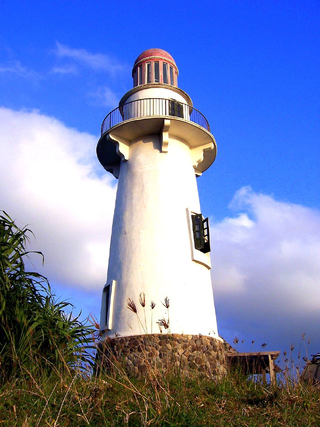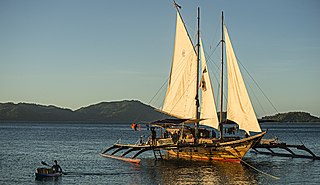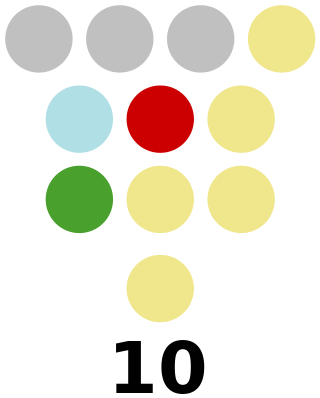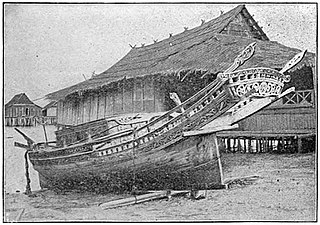
Batanes, officially the Province of Batanes, is an archipelagic province in the Philippines, administratively part of the Cagayan Valley region. It is the northernmost province in the Philippines, and the smallest, both in population and land area. The capital is Basco, located on the island of Batan.

Batan Island is the main island of Batanes, an archipelagic province in the Philippines. It is the second largest of the Batanes Islands, the northernmost group of islands in the Philippines.

The Ivatan language, also known as Chirin nu Ivatan, is an Austronesian language spoken in the Batanes Islands of the Philippines.

Uyugan, officially the Municipality of Uyugan, is a 6th class municipality in the province of Batanes, Philippines. According to the 2020 census, it has a population of 1,380 people, making it the least populated town in the province and second least populated in the country, behind Kalayaan, Palawan.

The Ivatan people are an Austronesian ethnolinguistic group native to the Batanes and Babuyan Islands of the northernmost Philippines. They are genetically closely related to other ethnic groups in Northern Luzon, but also share close linguistic and cultural affinities to the Tao people of Orchid Island in Taiwan.
The Batanes National Science High School, formerly the Batanes National High School, is a public science high school in the Philippines, recognized by the Department of Education. It is in the provincial capital of Batanes, Basco and had an enrollment of 1,112 students in school year 2022–2023. The current principal is Carmen C. Noguera.

Basco Lighthouse is a lighthouse in the town of Basco in Batanes, the northernmost province in the Philippines. Located in Naidi Hills in Barangay San Antonio, the lush green hills and the open sea provide a beautiful backdrop for the lighthouse. The place can easily be reached by a 1.2-km hike from the Port of Basco.

A balangay, or barangay, is a type of lashed-lug boat built by joining planks edge-to-edge using pins, dowels, and fiber lashings. They are found throughout the Philippines and were used largely as trading ships up until the colonial era. The oldest known balangay are the Butuan boats, which have been carbon-dated to 320 AD and were recovered from several sites in Butuan, Agusan del Norte.

The Batanes Provincial Board is the Sangguniang Panlalawigan of the Philippine province of Batanes.

Silvino Artemio Barsana Agudo, also known as S.B. or Binong, was a Filipino businessman, lawyer, World War II veteran, and public servant. He was the governor of Batanes province from 1968 to 1971.
Avang, also known as abang or pontin, is a traditional trading ship of the Ivatan people of the Philippines. It is the largest boat type among the Ivatan people and characteristically has a closed deck. It is about 14 to 18 m in length and about 5 m (16 ft) in height. It is slightly curving, with the bow and the stern higher than the central area. It has two masts made from woven mats of pandanus leaves, though these were later replaced with canvas cloth (kacha) in colonial times. It also has fifteen pairs of rowers. The avang resembles the vasinian boats of the Yami people. Avang are extinct, the last ship was dismantled in 1910.

Ijangs are the terraced hillfort settlements of the Ivatan people built on hill tops and ridges in the Batanes Islands of the Philippines. These high rocky formations can serve as fortress or refuge against attacking enemies for the Ivatan people.

Karakoa were large outrigger warships from the Philippines. They were used by native Filipinos, notably the Kapampangans and the Visayans, during seasonal sea raids. Karakoa were distinct from other traditional Philippine sailing vessels in that they were equipped with platforms for transporting warriors and for fighting at sea. During peacetime, they were also used as trading ships. Large karakoa, which could carry hundreds of rowers and warriors, were known as joangas by the Spanish.

Lepa, also known as lipa or lepa-lepa, are indigenous ships of the Sama-Bajau people in Indonesia, the Philippines, and Malaysia. They were traditionally used as houseboats by the seagoing Sama Dilaut. Since most Sama have abandoned exclusive sea-living, modern lepa are instead used as fishing boats and cargo vessels.

Bangka are various native watercraft of the Philippines. It originally referred to small double-outrigger dugout canoes used in rivers and shallow coastal waters, but since the 18th century, it has expanded to include larger lashed-lug ships, with or without outriggers. Though the term used is the same throughout the Philippines, "bangka" can refer to a very diverse range of boats specific to different regions. Bangka was also spelled as banca, panca, or panga in Spanish. It is also known archaically as sakayan.

Falua, also spelled faluwa, is a traditional open-deck boat of the Ivatan people from the islands of Sabtang and Batan in the Philippines. It is about 8 to 12 m long and has one mast. It can also be propelled by six to ten pairs of rowers. It can carry thirty passengers and is used to ferry goods between the islands. Modern falua are generally motorized. Falua is similar in shape to the chinarem but differs in that it is usually larger and has a flat transom.
Chinedkeran is a traditional open-deck boat of the Ivatan people from the island of Itbayat in the Philippines. It is similar in size to the falua, with five to thirteen pairs of rowers and a single sail. It is characteristically wide with high strakes due to the rough seas surrounding Itbayat.
Chinarem was a traditional open-deck boat of the Ivatan people from the island of Sabtang in the Philippines. It was around 6 to 8 m long with three or four pair of rowers and a single mast. It was similar to the falua in shape, but differs in that the stern was pointed. It can carry ten passengers and was generally used to ferry goods and people between the islands of Sabtang and Batan. Chinarem is extinct, it disappeared in Sabtang Island around the 1970s.
Panineman is a traditional open-deck fishing boat of the Ivatan people from the island of Itbayat in the Philippines. It is slightly larger than the largest types of tataya, and can accommodate three pairs of rowers and a single sail.

Ipanitika, also known as chinedkulan, are traditional fishing boats of the Tao people of Orchid Island, Taiwan. They are around 7.6 m (25 ft) and can carry up to 10 to 14 people. Smaller versions of the ipanitika is known as the tatara or tatala, which are around 2.3 m (7.5 ft) long and can carry at least 2 people. They were propelled by oars mounted on a row of rope-wrapped posts that are slotted into a shelf built into the hull of the boat.





















